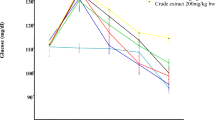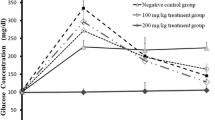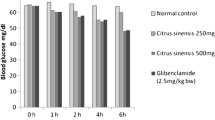Abstract
Anti-diabetic effects of wild Korean ginseng extracts on multiple low-dose streptozotocin (STZ)-induced diabetic rats were investigated. Rats were administered extracts at rates of 100, 200, and 300 mg/kg of body weight for 8 weeks. Body weight was significantly (p<0.05) lower in ginseng untreated diabetic rats than in ginseng treated rats in spite of significantly (p<0.05) higher food and water intake than for ginseng treated rats. Blood glucose levels were significantly (p<0.05) higher but plasma insulin levels were significantly (p<0.05) lower in 200 and 300 mg/kg of body weight ginseng treated diabetic rats than in rats treated with 100 mg of ginseng and in untreated control rats. The plasma aspartate aminotransaminase level was not significantly (p>0.05) affected; however alanine aminotransaminase and alkaline phosphatase levels were reduced significantly (p<0.05) in higher ginseng dosage rat groups. Anti-diabetic effects were elicited by administration of wild Korean ginseng extracts in multiple low-dose STZ-induced diabetic rats.
Similar content being viewed by others
References
Kitts DD, Hu C. Efficacy and safety of ginseng. Public Health Nutr. 3: 473–485 (2000)
Christensen LP. Ginsenosides: Chemistry, biosynthesis, analysis, and potential health effects. pp. 1–99. In: Advances in Food and Nutrition Research. Taylor S (ed). Academic Press, Burlington, MA, USA (2008)
Hays NP, Galassetti PR, Coker RH. Prevention and treatment of type 2 diabetes: Current role of lifestyle, natural product, and pharmacological interventions. Pharmacol. Therapeut. 118: 181–191 (2008)
Park EY, Kim HJ, Kim YK, Park SU, Choi JE, Cha JY, Jun HS. Increase in insulin secretion induced by Panax ginseng berry extracts contributes to the amelioration of hyperglycemia in streptozotocin-induced diabetic mice. J. Ginseng Res. 36: 153–160 (2012)
Blumenthal M, Cavaliere C, Ferrier GKL. Total sales of herbal supplements in the United States show steady growth. HerbalGram 71: 64–66 (2006)
Court WE. The Genus Panax. pp. 13–21. In: Ginseng, the Genus Panax. Court WE (ed). Harwood Academic Publishers, Amsterdam, Netherlands (2005)
Wang XY, Zhang JT. Effect of ginsenoside Rb1 on mouse sexual function and its mechanism. Acta Pharm. Sin. 35: 492–495 (2000)
Gillis CN. Panax ginseng pharmacology: A nitric oxide link? Biochem. Pharmacol. 54: 1–8 (1997)
Vuksan V, Stavro MP, Sievenpiper JL, Beljan-Zdravkovic U, Leiter LA, Josse RG, Xu Z. Similar postprandial glycemic reductions with escalation of dose and administration time of American ginseng in type 2 diabetes. Diabetes Care 23: 1221–1226 (2000)
Kiefer D, Pantuso T. Panax ginseng. Am. Fam. Physician 68: 1539–1542 (2003)
Ohnishi Y, Takagi S, Miura T, Usami M, Kako M, Ishihara E, Yano H, Tanigawa K, Seino Y. Effect of ginseng radix on GLUT2 protein content in mouse liver in normal and epinephrine-induced hyperglycemic mice. Biol. Pharm. Bull. 19: 1238–1240 (1996)
Maiti R, Jana D, Das UK, Ghosh D. Antidiabetic effect of aqueous extract of seed of Tamarindus indica in streptozotocin-induced diabetic rats. J. Ethnopharmacol. 92: 85–91 (2004)
OECD. Guidance document on acute oral toxicity testing. Organization for Economic Co-operation and Development, Paris, France. pp. 10–13 (2001)
Srinivasan K, Viswanad B, Asrat L, Kaul CL, Ramarao P. Combination of high-fat diet-fed and low-dose streptozotocintreated rat: A model for type 2 diabetes and pharmacological screening. Pharmacol. Res. 52: 313–320 (2005)
Zhao Z, Zhao C, Zhang XH, Zheng F, Cai W, Vlassara H, Ma ZA. Advanced glycation end products inhibit glucose-stimulated insulin secretion through nitric oxide-dependent inhibition of cytochrome c oxidase and adenosine triphosphate synthesis. Endocrinology 150: 2569–2576 (2009)
Suzuki Y, Ito Y, Konno C, Furuya T. Effects of tissue cultured ginseng on gastric secretion and pepsin activity. Yakugaku Zasshi 111: 770–774 (1991)
Attele AS, Zhou YP, Xie JT, Wu JA, Zhang L, Dey L, Pugh W, Rue PA, Polonsky KS, Yuan CS. Antidiabetic effects of Panax ginseng berry extract and the identification of an effective component. Diabetes 51: 1851–1858 (2002)
Sotaniemi EA, Haapakoski E, Rautio A. Ginseng therapy in noninsulin-dependent diabetic patients: Effects on psychophysical performance, glucose homeostasis, serum lipids, serum aminoterminalpropeptide concentration, and body weight. Diabetes Care 18: 1373–1375 (1995)
Kang KS, Kim HY, Yamabe N, Nagai R, Yokozawa T. Protective effect of sun ginseng against diabetic renal damage. Biol. Pharm. Bull. 29: 1678–1684 (2006)
Minet-Ringuet J, Even PC, Lacroix M, Tomé D, de Beaurepaire R. A model for antipsychotic-induced obesity in the male rat. Psychopharmacology 187: 447–454 (2006)
Cooper GD, Pickavance LC, Wilding JP, Harrold JA, Halford JC, Goudie AJ. Effects of olanzapine in male rats: Enhanced adiposity in the absence of hyperphagia, weight gain or metabolic abnormalities. J. Psychopharmacol. 21: 405–413 (2007)
von Wilmsdorff M, Bouvier ML, Henning U, Schmitt A, Gaebel W. The impact of antipsychotic drugs on food intake and body weight and on leptin levels in blood and hypothalamic ob-r leptin receptor expression in wistar rats. Clinics 65: 885–894 (2010)
Lee WK, Kao ST, Liu IM, Cheng JT. Increase of insulin secretion by ginsenoside Rh2 to lower plasma glucose in wistar rats. Clin. Exp. Pharmacol. P. 33: 27–32 (2006)
Vuksan V, Sievenpiper JL, Koo VY, Francis T, Beljan-Zdravkovic U, Xu Z, Vidgen E. American ginseng (Panax quinquefolius L.) reduces postprandial glycemia in nondiabetic subjects and subjects with type 2 diabetes mellitus. Arch. Intern. Med. 160: 1009–1013 (2000)
Sesti G. Apoptosis in the beta cells: Cause or consequence of insulin secretion defect in diabetes? Ann. Med. 34: 444–450 (2002)
Ibrahim DA. Study of the effect of Panax ginseng versus gliclazide on hyperglycaemia-induced by dexamethasone in experimental animals. Sultan Qaboos Univ. Med. J. 9: 63–69 (2009)
Karaca T, Yoruk M, Yoruk IH, Uslu S. Effects of extract of green tea and ginseng on pancreatic beta cells and levels of serum glucose, insulin, cholesterol and triglycerides in rats with experimentally streptozotocin-induced diabetes: A histochemical and immunohistochemical study. J. Anim. Vet. Adv. 9: 102–107 (2010)
Chan CB, MacDonald PE, Saleh MC, Johns DC, Marban E, Wheeler MB. Over expression of un-coupling protein 2 inhibits glucose-stimulated insulin secretion from rat islets. Diabetes 48: 1482–1486 (1999)
Zhang CY, Baffy G, Perret P, Krauss S, Peroni O, Grujic D, Hagen T, Vidal-Puig AJ, Boss O, Kim YB, Zheng XX, Wheeler MB, Shulman GI, Chan CB, Lowell BB. Uncoupling protein-2 negatively regulates insulin secretion and is a major link between obesity, beta cell dysfunction, and type 2 diabetes. Cell 105: 745–755 (2001)
Bei WJ, Guo J, Wu HY, Cao Y. Lipid-regulating effect of traditional Chinese medicine: Mechanisms of actions. Evid.-Based Compl. Alt. 2012: 1–10 (2012)
Author information
Authors and Affiliations
Corresponding author
Rights and permissions
About this article
Cite this article
Moon, HK., Kim, KS., Chung, SK. et al. Effect of wild Korean ginseng (Panax ginseng) extract on blood glucose and serum lipid contents in rats with multiple low-dose streptozotocin-induced diabetes. Food Sci Biotechnol 24, 1505–1511 (2015). https://doi.org/10.1007/s10068-015-0194-9
Received:
Revised:
Accepted:
Published:
Issue Date:
DOI: https://doi.org/10.1007/s10068-015-0194-9




